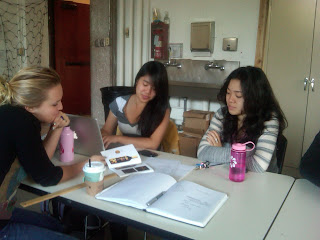 |
| Assembling the bottles |

For the final project, we were instructed that the class would be broken up in to groups of three or four people, and each group would develop a cencent for a collaborative class project. Each project proposal had to aim to showcase each designers work in set or series. While various media could be used to develop the imagery or text, all design pieces had to be digital in the final format and converted into a process color image. To narrow down which project the class would all rally behind and produce, we had a critique day where we went thru each proposal and voted on the final project that would go in to action. My group made a proposal to each design a wine label for a set of government approved wine brand names that were in need of labels before they could be bottled and shipped out across the nation. My family friend, Paul Kalemkiarian, is a wine entrepreneur that owns the "Wine of the Month Club" based in Monrovia, California. He owns the rights to six "brand names" for wines, kind of like the equivalent to owning a web domain or something, before the actual site has been created. The exciting part about this project is that each student, depending on the strength and accuracy of their design in following labeling regulations and policies, would automatically carry the potential to be picked up and used for bottling and shipped out across the country!- granted that Mr. K would want to use it. Although our class had several strong ideas that would have been successful in satisfying the project requirements, our class was very ambitious in that they went ahead and selected my group's project.
 |
| Production 2: Final revision of the booklet |
Here is a link to the Googledocs that will further reveal the process and updates that the class received throughout the course of the project: https://docs.google.com/leaf?id=0B5_qqmqZDVC8NWMwYzc3NGItNTQzNy00OWNiLThkMmItYWJhM2E2YWU5YjVk&hl=en&invite=CLqg4fsC
Here is the brief I wrote for the introduction of the booklet/ catalogue:
 |
| The Booklet!! |
It all started out when we obtained permission to work with six government-approved wine “brand names”. They held potential to exist as bottled wines in the world, but were nothing more than names- they lacked an image, they lacked labels. This is where we stepped in as designers. Our challenge was to each interpret one of the wine names however we saw fit, keeping in mind our target audience as well as government labeling regulations. We all addressed the same fundamental “problems” by utilizing our personal strengths as designers. Therefore, through wine labels, our individual aesthetics are showcased in a uniform format, allowing us to present the range of possibilities for something that deserves the unique consideration of a designer. Now these brand names and blank bottles have been given the visual design elements they once lacked, fulfilling their potential to be produced, bottled, and enjoyed.
 |
| Removing the labels in the bathtub :) |
I began by going to a market to observe the wine aisle and get my hands on some bottles to see what I liked and didn't like, what popped off the shelf, what spoke sophistication, etc., etc. I found this step to be really helpful in getting fresh ideas and see the range of possibilities in bending the rules/laws of label design in order to incorporate all of the required elements without sacrificing artistic design.
 |
| dancing man doodle |

No comments:
Post a Comment